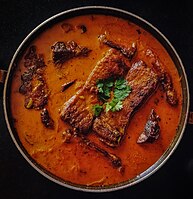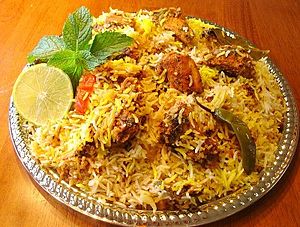ベンガル料理
Bengali cuisine/ja
| この記事はシリーズの一部である |
| インド料理 |
|---|
 |
|
|
ベンガル料理は、ベンガル(バングラデシュ、インドの州西ベンガル州、およびアッサム州のカリムガンジ県)の料理様式である。この料理は、この地域の多様な歴史と気候によって形成されてきた。マスタードオイルを含む多様な風味の使用、および菓子やデザートの普及で知られている。米が主食として強く重視されており、伝統的に魚が最も一般的なタンパク質源である。海水魚よりも淡水魚が好まれるが、bhetkiとして知られるアカメも一般的である。肉もベンガル人の間で一般的なタンパク質であり、鶏肉とマトンが最も人気がある。牛肉はイスラム教徒コミュニティで人気がある。近年では、レンズ豆が食事の重要な部分を占めるようになっている。多くのベンガル料理の伝統は、アッダ、ポヘラ・ボイシャク、イード、ドゥルガー・プージャーなどの宗教的および社会的な機能に由来している。
料理への影響
ムガル帝国の影響
イスラム教徒は13世紀半ば頃にベンガルを征服し、ペルシア料理とアラビア料理をもたらした。ビリヤニ、コルマ、ブーナといった料理はかつては上流階級の食事であったが、ムガル帝国の料理人たちはそのレシピを下層階級や中流階級にも広めた。この影響はイギリス領インド帝国の支配下で強まり、コルカタは多くの著名な追放されたナワーブ、特にマイソール王国のティプー・スルターンの家族や追放されたアワドのナワーブであったワージド・アリー・シャーの避難場所となった。亡命者たちは数百人の料理人とmasalchis(スパイス混合人)を連れてきており、彼らの王室の庇護と富が減少するにつれて、彼らは地元住民の中に混じり合っていった。これらの料理人たちは、非常に広範囲のスパイス(特にサフランとメース)、ギーの広範な使用、ヨーグルトと唐辛子で肉をマリネする知識を持っていた。

バングラデシュでは、これらの料理は一般の人々の一般的な食事となっているが、西ベンガルでは、プロの料理人の食事に留まっている。さらなる革新には、チャップ(タワでゆっくり調理されたリブ)、レザラ(薄いヨーグルトとカルダモンのグレイビーソースで煮込んだ肉)、カティロール(ラップに入ったケバブ)などがある。
ムガル人は肉に特別なこだわりがあり、鶏肉や鹿肉など既に知られていた種類の肉に加えて、マトンや牛肉をベンガル料理の主流に取り入れた。
さらに、伝統的なデザートは主に米のペーストとジャガリーをベースにしていたが、ムガル帝国の影響下で、牛乳、クリーム、砂糖の使用が大幅に増加し、カルダモンやサフランのような高価なスパイスも加えられるようになった。

ベンガルヒンドゥー教の寡婦の影響
ベンガルヒンドゥー教の伝統において、寡婦は「苦い」と分類されない食品を食べることが許されていなかったため、工夫と革新が必要とされた。ほとんどのベンガルカーストは肉や魚を食べていたが、これは寡婦には禁じられていた。寡婦はまた、エシャロットやニンニクのような「体を温める」食品を使うこともできなかったが、ショウガは許されていた。この調理法は、ベジタリアン料理と非ベジタリアン料理の両方において、ベンガルカレー全般の重要な位置を占めるようになった。サフラン、シナモン、クローブのような高価なスパイスは、もし使われたとしても非常に控えめにしか使われなかった。ナッツ、ドライフルーツ、牛乳、乳製品(クリーム、ギー、カードなど)も同様に少なかった。これらの経済的および社会的な制約は、ベンガルの寡婦たちに、野菜と安価なスパイスのみを利用したまったく新しい食事のセットを生み出すきっかけを与えたのである。
ベンガル分割
インド分割によって宗教を理由とする大規模な住民の移動が起こり、宗教的制限を遵守するため、食事の摂り方に変化が生じた。バングラデシュ(旧東ベンガルおよび東パキスタン)では、ムガル料理が一般的であり、牛肉のケバブなど、西ベンガルではあまり普及していない食品も含まれている。加えて、ザルダやフィルニ・パエシュのような甘いものも食されている。バングラデシュの農村部では、多くの人々がマクナを揚げたり、ポン菓子にしたり、生で食べたりする。
植民地時代には、多くの西洋食品店がコルカタに設立され、パフペイストリー、チャンナ、チョコレート、チップスなどが特に普及した。チョップ、グレイビーカツレツ、スポンジロショゴッラ、レディケニなどの料理が生まれた。多文化コミュニティの結果として、コルカタの料理は絶えず変化し、中華料理やヨーロッパ料理から大きな影響を受けている。
特徴
ベンガル料理は、以下の4つの異なる種類の料理に細分できる。
- 食べられるもの(খাদ্য, ভক্ষ্য, or ভোজ্য):চর্ব্য, chôrbyô、つまり噛めるもの。米や魚など。
- 吸えるもの(চোষ্য, choshyô):アンバルやタックなど。
- 舐められるもの(লেহ্য, lehyô):チャツネなど。
- 飲めるもの(পেয়, peyô):主に牛乳を含む飲み物。
郷土料理

ベンガルの様々な地域が特定の料理、食材、材料で有名である。例えば、シュンドルボン周辺の南ベンガルの地域では、高価なチュイ・ジャルという唐辛子が自慢で、彼らはこれを皮をむいて細かく刻み、料理に入れて強い香りを出す。一方、北ベンガルは、ボグラのミシュティ・ドイ、ナトールのカチャゴッラ、ポラバリのチョムチョムなど、多くのベンガルデザートの発祥地である。しかし、他の地域にも、ネトロコナのバリシュ・ミシュティ(枕の甘いもの)、ムクタガッチャのモンダ、ナバディープの赤いヨーグルト、コミラの有名なロシュモライなど、有名なデザートがある。
チッタゴン
チッタゴン・ベンガル料理の伝統は、主にメズバンと、牛肉の肩肉と伝統的なスパイスを使ったカラ・ブナのような混ぜご飯料理で知られている。干し魚(shutki)は、ベンガルの他の地域よりもチッタゴン地域でより多く入手可能である。
メズバン
メズバン(Mezban)(地元ではMejjanとして知られる)は、バングラデシュのチッタゴン地方における特別な日のごちそうを意味するベンガル語である。歴史的にメズバニは伝統的な地域の祝宴であり、人々は白米と牛肉、その他動物性脂肪や乳製品を豊富に使った料理を楽しむために招かれる。これは、命日、誕生日、成功の祝賀、新しいビジネスの開始、新居への入居、子供の誕生、結婚、アキーカ、割礼、女子の耳のピアス、新生児の命名などの機会に開催される。メズバニの招待は通常、誰に対しても開かれており、様々な場所や近隣の人々が祝宴への招待を伝える。都市部では、メズバンへの出席は招待制である。通常、メズバニでの食事の消費は午前中から午後にかけて行われる。
牛肉をベースにした料理はベンガル・ムスリムに好まれ、メズバンでの社会的名声の象徴である。富裕層も貧困層も、状況が許す限り様々な機会に祝宴を催す。メズバンには独特の調理法があり、適切なメズバン肉には特定の技術が求められる。例えば、この祝宴で提供される独特のビーフカレーはMezbani goshtとして知られており、その独特のレシピは本質的にチッタゴンの料理人に限られている。

ヒンドゥー教の伝統では、メズバンを調理する際に牛肉の代わりに魚が使われる。チッタゴンのヒンドゥー教徒コミュニティは、「チッタゴン・パリシャド」の旗印の下、毎年メズバニを組織しており、魚、野菜、干し魚で作られたカレーが提供される。
ダッカ
ダッカ料理は、ベンガル地方の最も注目すべき郷土料理の1つである。豊かな料理の習慣は、ムガル料理、中央アジア料理、アルメニア料理、ヒンドゥスターニー料理、および土着のベンガル料理の影響を受けている。しかし、ダッカ独特の料理もある。ダッカのナワーブはムガル料理をベンガルにもたらし、それがダッカの料理界に完全に保持された。ムガル料理の製造コストが高かったため、そのレシピは植民地時代のインドではエリート階級に限られていたが、バングラデシュ経済の成長とともにゆっくりと広がっていった。ラム肉、マトン、牛肉、ヨーグルト、マイルドなスパイスを重視することが、このスタイルの味を特徴づけている。ケバブ、詰め物パン、カッチ・ビリヤニ、ラム肉、アヒル、鶏肉のロースト、パティサプタ、カシミールティー、コルマなどの料理は、イードや結婚式などの特別な行事で今でも提供されている。
古都ダッカは、有名なピラフの一種であるモログ・ポラオが自慢である。これは、米を後から炊き、鶏肉を切り分けて調理するものである。その他のポラオには、イリシュ・ポラオやルイ・ポラオなどがある。ダッカの人々は、パニールとゆで卵をキチュリに導入したことで知られている。ダッカ・バカルカニは、厚くてビスケットのような平たいパンで、伝統的な屋台の軽食であり、その品質と味で有名である。主に紅茶と一緒に供される。ダッカの人々は、様々なハーブやスパイスを使って最高のキリ・パーンを作るという遺産を誇りにしている。また、糖尿病患者向けの「パーン・アフサナ」と呼ばれるキリ・パーンも提供している。ハジ・ビリヤニは、1939年にレストラン経営者が考案した料理で、味付けの濃い米、ヤギ肉、数種類のスパイスとナッツで作られている。このレストランはダッカ文化に不可欠な一部となっている。
コルカタ

コルカタでは、多くの地元の露天商が小さな店を構え、自家製の品物を販売している。チーズ(パニール)のような品はそのまま食べたり、甘いサンデシュ、ロソマライ、ロショゴッラ、またはチャナール・パエシュにしたりできる。牛乳は特にコルカタの様々な種類のパエシュに使われ、様々な穀物や、デーツ、イチジク、ベリーなどの添加物の使用が異なる。チョコレートのようなヨーロッパの食品に加えて、コルカタは中国系移民から料理の影響を受けている。インドの他の地域ではパニプリとして知られているフチカは、揚げた生地の皮にジャガイモとひよこ豆の詰め物を入れた一般的なベンガルの屋台料理で、通常、ベルプリ、マサラチャイ、ググニ、チャートの屋台の隣の小さな屋台で見られる。
Influences
During the 19th century many Odia cooks migrated to Bengal to work in the households of affluent Kolkata families. They were also hired to cook in weddings and other family ceremonies. Introduction of Odia cooks into their kitchens brought in subtle but significant changes to Kolkata's cuisine. Some of Kolkata's classic dishes were originally from Odisha but were refined in Kolkata kitchens by Odia cooks. In fact some researchers say that dishes like kanika (Bengali mishti pulao) were first introduced to Kolkata kitchens by Odia cooks although this is contested by other researchers.
The Chinese of Kolkata originally settled into a village called Achipur south of Kolkata in the late 18th century, later moving into the city and finally into its present home in Tangra at the eastern edge of Kolkata. The Chinese-origin people of Kolkata form a substantial and successful community with a distinct identity. With this identity came Chinese food, available at almost every street corner in Kolkata at present, due to the taste, quick cooking procedure, and no similarity with the original Chinese recipe other than the use of soy sauce. They were mostly Cantonese tradesmen and sailors who first settled down here and decided to cook with whatever items they had at hand.
Calcuttan immigrants to other countries have started carrying this abroad as well; Indian Chinese restaurants have appeared in many places in the United States and UK.
Indian Chinese food has been given a second boost in popularity since the 1950s when a large number of Tibetans migrated into Indian Territory, following the 14th Dalai Lama's flight. Tibetans brought their own taste preferences to add to the genre, such as the popular momo (a kind of dumpling) or thukpa (a hearty noodle soup). Tibetans and Nepali immigrants found ready employment in the many kitchens that can now be found on virtually every street in Kolkata.
Adda
Adda (Bengali: আড্ডা) is a traditional Bengali means of socialising over food during the work day. Food taken during adda consists usually of mishti or sweetmeats, tea, and coffee, although heartier meats such as fried fish may be brought out as well.
Being a hobby for artisans, women were largely secluded from adda, a sentiment that has begun to disappear with the democratization of adda and women occupying a larger space in social life. For this reason, adda was seen as a refuge "...from the home, a neutral rendezvous away from both the perceived drudgery of the workplace and domesticity"."You could be discussing Charles and Camilla's marriage this moment, and the next moment you're swinging over to the latest cricket series between India and Pakistan, and then swing back to the recent controversy over Tagore."
In the post-colonial era, the adda has been fading due to the more rigid structure of work and exploitative perceptions of unnecessary laziness. This has inspired a sizeable movement of Bengalis who believe it integral to the idea of lyadh, or doing nothing to relax and recharge. However, adda does still exist, being attended during vacation time or after work at clubs or coffee shops. The tradition even has an equivalent to the Greek symposium, as students may meet for a study session over food or have a teacher teach in a more relaxed environment.
Sylhet
Sylhet boasts a variation of the famous pilaf dish – Akhni polao – in which the rice is cooked after and the chicken pieces are cut. Commonly consumed varieties of meat include beef, chicken, mutton and duck/goose in dishes such as Hash O Bash. They also proudly hold the heritage of Beef Hatkora, a rice dish consisting of a wild citrus fruit not found in other parts of Bengal.
During the British period, biscuits and loaves were introduced in Sylhet and received popularity within the Muslim community. The middle-class Hindus of Cachar and Sylhet however were very suspicious of biscuits and breads as they believed they were baked by Muslims. In one occasion, a few Hindus in Cachar caught some Englishman eating biscuits with tea which caused an uproar. The information reached the Hindus of Sylhet and a little rebellion occurred. In response to this, companies started to advertise their bread as "machine-made" and "untouched by (Muslim) hand" to tell Hindus that the breads were "safe for consumption". This incident is mentioned in Bipin Chandra Pal's autobiography and he mentions how gradually culinary habits of Hindus eventually changed.
Utensils

A korai is a cooking vessel for most Bengali sauces and stir-fry. The dekchi (a flat-bottomed pan) is used generally for larger amounts of cooking or for making rice. It comes with a thin flat lid which is used also to strain out the starch while finishing up cooking rice. The tawa is used to make roti and paratha. The other prominent cooking utensil is a hari, which is a round-bottomed pot-like vessel. The three mentioned vessels all come in various sizes and in various metals and alloys.
A flat metal spatula, khunti, is used often, along with hata (scoop with a long handle), jhanjri (round-shaped sieve-like spatula to deep-fry food), the shanrashi (pincers to remove vessels from the fire), the ghuntni (wooden hand blender) for puréeing dal, the wooden belun chaki (round pastry board and rolling pin), and the shil nora, which is a rough form of a mortar and pestle or grinding stone. The kuruni is used only to grate coconuts.
Silverware is not a part of traditional Bengali cookery.
Historical

Bengalis usually eat sitting on the floor with food served on a dostorkhan. They historically ate without silverware, with a large banana or plantain leaf serving as the plate, or with plates made from dried sal leaves sewn together.
It is customary to offer guests food and drink appropriate to the time of their visit. At meals, guests are served first, with the possible exception of very old or very young members of the host family. Within the family, serving starts with the senior males (those of highest social rank or eldest). School-age children are served before wives, daughters-in-law, and the cook, who are the last to eat.
Contemporary
Prior to colonisation, adherence to meal order was a marker of social status, but with British and Portuguese influence and the growth of the middle class, this has slowly disappeared. Courses are frequently skipped or combined with everyday meals. Meals were usually served course by course to the diners by the youngest housewives, but increasing influence of nuclear families and urbanisation has replaced this. It is common to place everything on platters in the centre of the table, and each diner serves themselves. Ceremonial occasions such as weddings used to have elaborate serving rituals, but professional catering and buffet-style dining is now commonplace. However, large family occasions and more lavish ceremonial feasts may still abide by these rules.
Meals
Daily meals are usually simple, geared to balance nutrition and making extensive use of vegetables. The courses progress broadly from lighter to richer and heavier and go through various tastes and taste cleansers. Rice remains common throughout the meal and is the main constituent of the meal, until the chaţni (chutney) course.
Main course
Fish
Fish is a core part of the Bengali diet, and is the main source of protein. Bengalis typically use freshwater and brackish fish when making meals. Spices are used heavily in the preparation of fish, and the fish is usually served either as a curry or a fried steak. Popular fish curries include boal, rohu, ilish, and pabda.
One tradition includes the left side of the cidal fish being cooked in oil.
Sweets
Bengali sweets have a long history. The Portuguese friar Sebastien Manrique, travelling in the region in the 17th century, noted the multitude of milk-based foods and sweets prepared in traditional ways. Falooda, shahi jilapi and shemai are popular sweet foods and desserts.
Rosogolla
Rosogolla, a Bengali traditional sweet, is one of the most widely consumed sweets in India. It spread to Bengal in 1868. Chhana based sweets were introduced in Eastern India from about the 18th century; as the process and technology involved in synthesizing "Chhana" was introduced to the Indians by the Dutch in the 1790s. The cottage cheese "schmierkase" was also known as Dutch cheese. The earlier versions of Rossogolla lacked binding capacity of the modern avatar that is well known and highly acclaimed today. This was due to the fact that the know-how involved in synthesizing such a sweet was unknown before being experimentally developed by Nobin Chandra Das and then constantly improved and further standardized by his successors. Furthermore, the "chhana" manufactured in those days was a coarse and granular variety and had low binding capacity. It was made by citric and ascorbic acid from natural fruit extracts. This type of "chhana" cannot be worked on to compact into any regular and firm shape for the purpose of sweet-making, leave alone making Rossogolla. This is because of a documented technological issue – lactic acid (extracted from whey) used to curdle milk now was introduced to India in the late 18th century by Dutch and Portuguese colonists (along with acetic acid). It is this method that creates the fine, smooth modern "chhana" with high binding capacity – which is now the staple raw material for Bengali confectioners. At present, Nobin Chandra Das is referred to have invented the spongy variant of rossogolla.
Darbesh
Laddu (or as it is known as "darbesh" in Bengal) is a very common sweet in West Bengal and Bangladesh, as well as the rest of the subcontinent, especially during celebrations and festivities. They are usually made out of flour, ghee/butter/oil and sugar. Alternative recipes can be made of coconut shavings and jaggery, raisins, chopped nuts, oatmeal, khoa, nutmeg, cardamom, or poppy seeds, among other ingredients. The sweet dates back to the year 4 BCE, where it was used for medicinal purposes and to keep the hormones of 9-11-year-old girls' "in check".
Pantua
Pantua is similar to gulab jamun, and could be called a Bengali variant of that dish.
Other sweets
Several varieties of doi such as mishţi doi, fruit-floured doi like aam doi, custards, and rice pudding (khir or firni) are also popular in West Bengal.
Shôndesh, chhanar jilapi, kalo jam, raghobshai, "pantua", "jolbhora shondesh","roshbhora", "lord chomchom", payesh, bundiya, nalengurer shôndesh, malpoa, shor bhaja, langcha, babarsa, and a variety of others are examples of sweets in Bengali cuisine.
飲料
一般的な飲料には、ショルボット、ラッチ、ゴール、マタ、ファルーダ、ルー・アフザなどがある。ベンガル茶の主な2種類は、ドゥドゥ・チャ(ミルクティー)とマサラ・チャである。ベンガルの紅茶の都であるスリマンガルはセブンカラーティーで有名であり、ダッカはボルハニで有名である。伝統的なフルーツジュース(rosh)も飲まれており、サトウキビジュース、マンゴージュース、パームフルーツジュース、デーツジュース、さらにバジルシードやトゥクマをベースにした飲み物などがある。
ギャラリー
-
パンタ・バートとイリシュ・バジャ、ボルタ。人気のベンガル正月料理。
-
伝統的なベンガル式イフタールバザール
-
ベンガルの非常に伝統的な食事
-
ベンガル料理の豪華な盛り付け
-
ベンガル地方のベジタリアン料理
関連項目
| この記事は、クリエイティブ・コモンズ・表示・継承ライセンス3.0のもとで公表されたウィキペディアの項目Bengali cuisine(11 June 2025, at 01:42編集記事参照)を翻訳して二次利用しています。 |









